
 So it’s wedding season for many Panjabis in the Diaspora and one key product commonly used across South Asian groups is batnaa (the yellow mixture used on a groom/bride a day before the wedding to clear up the complexion). Guess what? Jessica Alba is now on boxes of Batnaa! When I saw this I laughed and got confused … what is going on here? I find it interesting that Alba is on the box … maybe it’s because she “looks” more South Asian than say Hillary Duff? Any other ideas?
So it’s wedding season for many Panjabis in the Diaspora and one key product commonly used across South Asian groups is batnaa (the yellow mixture used on a groom/bride a day before the wedding to clear up the complexion). Guess what? Jessica Alba is now on boxes of Batnaa! When I saw this I laughed and got confused … what is going on here? I find it interesting that Alba is on the box … maybe it’s because she “looks” more South Asian than say Hillary Duff? Any other ideas?


Also, American stars are being used to market traditional South Asian products rather than relying on Bollywood stars. Anyone else out there seen something similar in marketing other traditional South Asian products?
Ishmeet Singh, the winner of the “Voice of India” contest, passed away today after drowning in a hotel swimming pool in the Maldives. He was the only son of his parents, and was set to perform at an event in Maldives capital. Such a tragic story and such a great loss for the Punjabi community. Ishmeet had been vocal about his intent to encourage Sikh youth to step out of the shadows and achieve their dreams.
Ishmeet had been vocal about his intent to encourage Sikh youth to step out of the shadows and achieve their dreams.
This talented Sikh turned out to be very humble, polite, and caring. His idea on winning rested in the ultimate sense to have faith in Waheguru wholeheartedly. He is an idol to many young Sikhs all around the world and he can inspire and motivate young Sikh men and women to succeed in life without compromising their values and traditions under any pressure whatsoever. While interviewing him, he very clearly said to me that in future he would do everything in his power to help Sikh youth with talent to step out of the shadow.
His Shabad Kirtan CD had just been released and many were hoping to see the beginning of a wonderful journey for Ishmeet. He will be greatly missed.
Previous Coverage of Ishmeet on the Langar Hall:
Some of you may have followed the case of Sarika Singh, a Welsh-Sikh student who was barred from school when the organization adopted a dress code that prohibited wearing jewelry, including religious items. Instead of conforming to the dress code or transferring schools, Singh appealed to the school. When officials refused to reverse their decision or provide exception for the kara (not an item of jewelry, but rather an article of faith), Singh sued under the UK’s anti-discrimination laws. She has been excluded from classes and from attending school for the past nine months.
Moments ago, the BBC reported that the UK’s High Court affirmed her case, stating that the dress code unfairly burdened Singh’s freedom of religious expression. Both advocates and the court expressed frustration with the school, stating that the issue had been clearly defined in U.K. statutes and case law for over 20 years. This judgment opens the door for students of all religious backgrounds; in addition to the banning of the kara, other UK (private) schools have moved to ban the crucifix, the hijab, and the yarmulke. Against this “confining” interpretation of secularism (an interpretation more common on the European continent), the UK courts have clarified the intent of the country’s inclusionary and anti-discriminatory legal framework.
We’ll continue to update with details and analysis as information becomes available.
We’re continuing our coverage on Snoop Dogg in Bollywood. And now, we’re joined by the New York Times. Some may grimace at the thought of Snoop promoting Sikhs, but he’s definitely bringing us a LOT of exposure these days. 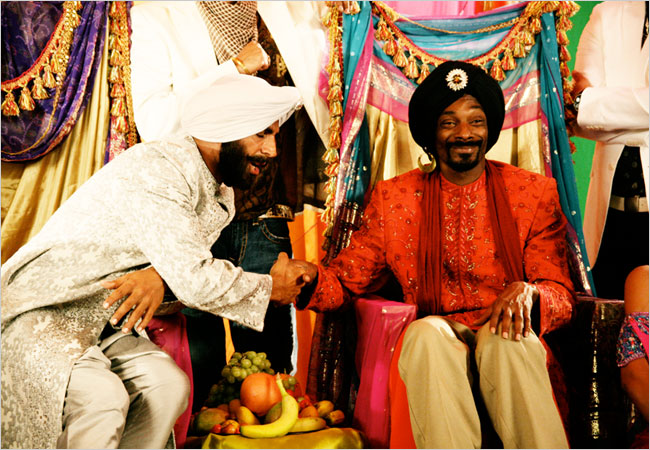
Snoop Dogg wears a Sikh turban and an ornate long coat called a sherwani in a video of the title song, which was shot this year in Chicago… “I really dig how much music is infused with the movies” in Bollywood, Snoop Dogg said in an e-mailed response to questions. “Lots of hip-hop tracks sample Indian music, and a lot of their music sounds like it was influenced by hip-hop,” he said. “We’re putting together something real big” in India, that will include collaborations, live shows and “more movies with some of my Bollywood homies.” [link]
Mewa Singh predicted that Snoop’s collaborative song with Bollywood would become the hottest new track with bhangra teams and Punjabis in the diaspora. It’s already taking over the airwaves in India, which is sort of a break through since hip hop has only been popular amongst the young, urban crowd there until now.
“I’m coming to take over Bollywood,” Snoop Dogg promised during the video shoot. “I’ve never been able to come over there and do shows for you all, but now I’m going to come and do shows,” he said in a clip that the video’s promoters put on YouTube. “This is just the beginning.” [link]
Ever wondered what Snoop thinks of you?
A recent decision of the British Columbia Human Rights Tribunal highlights some complex clashes within the Sikh community. The B.C. Human Rights Tribunal dismissed a complaint by two members of the Canadian community who were denied membership in a Burnaby gurdwara because of their caste.
But it’s not what you think. The men who were refused membership did not belong to a caste that was historically disadvantaged, but instead, were jats. And the group who did the refusing were the historically discriminated-against Ravidassia.
Gurshinder Sahota and Sohan Shergill said they were discriminated against by the Shri Guru Ravidass Sabha Temple because they belong to a higher caste in the traditional system of social ranking than do temple members… The 900 members of the Shri Guru Ravidass Sabha Temple belong to the lowest group, Dalits, formerly referred to as “untouchables” and often considered outside the caste system altogether. Sahota and Shergill are from the jat caste, which is traditionally a land-owning class in the Punjab and now makes up much of Metro Vancouver’s Sikh community. [link]
Vancouver’s Ravidassia community celebrated the decision, affirming their right to protection from the greater Sikh community.
The decision, released this week, was hailed as an affirmation of temple members’ right to gather as a “minority within a minority,” said spokesman Jai Birdi. “Since the decision has come out, the members are feeling quite empowered by it,” he said. “They’re feeling that this really reinforces their ability to come together as a marginalized community from India to talk about their heritage and historical unresolved issues and come up with some strategies for moving forward.” He added that the complainants are welcome to attend the temple’s religious ceremonies and social programs. [link]
When I was an undergraduate, I had the opportunity to attend the World Sikh Council – North America Region‘s conference on Women in Sikhi. The conference hosted panelists and speakers to discuss three broad categories: the depiction of women in Scripture (SGGS Ji), the treatment of women in the Rehit Maryada, and future possibilities/actions for promoting gender equity. The WSC, like many Sikh institutions, was heavily male-dominated at the time, although the conference liaisons did an admirable job trying to recruit a diverse panel of women to organize, speak, and develop the program. Nonetheless, the majority of conference attendees (until the very last panel) identified as men, and there was no conversation around the agency of men as allies in the struggle for gender equity. It’s always easier to criticize than construct, and I do think the conference was an important initial step; the organizers’ hearts were in the right place, and they were certainly attempting to place women at the center of the conversation.
What I found most distressing, however, was the deep level at which the “proper role” of women in Sikhi was gendered. In emphasizing the valuation of women, most speakers and commenters focused on the following passage from SGGS Ji (p. 473):
Woman becomes his friend; through woman, the future generations come.
When his woman dies, he seeks another woman; to woman he is bound.
So why call her bad? From her, kings are born.
From woman, woman is born; without woman, there would be no one at all.
Instead of focusing on the deeper meaning of this passage — that woman is a unique and necessary partner in the faith and in humanity –, most speakers placed the significance of women solely in the context of motherhood. As a result, the impact of women’s leadership is often reduced to a single meme: woman as cultural vessel — the bearer of children (Mata) and imparter of religious knowledge and instruction. This highly gendered role and image severely limits how we conceive of the role of women, both as public figures and speakers, but also in terms of their “value-added” to society.
This post is just for fun. A week ago, a fellow langa-(w)riter asked which Singh was really King? As the buzz for the upcoming “Singh is Kinng” movie continues, many had heard the news that Snoop Dogg had donned a pagh for a promotion with Akshay Kumar.
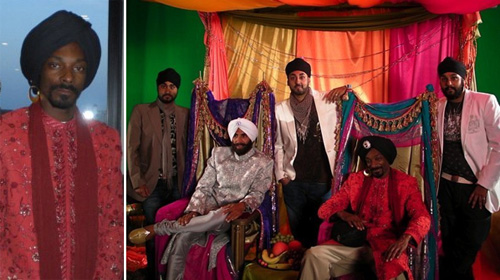 While many that were looking for Snoop Singh ended up finding this convert, my guess guess was that the people had something else in mind. Many people have emailed us asking if we had seen the picture of Snoop Dogg (for me he will always be Snoop Doggy Dogg) with the pagh. To make it easier for all of you internet hunters, here is the picture of Snoop with the turban, sitting like a king with Akshay.
While many that were looking for Snoop Singh ended up finding this convert, my guess guess was that the people had something else in mind. Many people have emailed us asking if we had seen the picture of Snoop Dogg (for me he will always be Snoop Doggy Dogg) with the pagh. To make it easier for all of you internet hunters, here is the picture of Snoop with the turban, sitting like a king with Akshay.
For a link explaining how Snoop came to don the turban in Chicago, you can read a link here.
Sources revealed that the rapper dressed exactly like a Sikh with a turban on his head while recording the track. They even said that the rapper was to have his own crew and clothes, but Akshay convinced him to wear a turban. [link]
This recent article about a granthi in Leeds suing for unfair dismissal brought me back to the topic of granthis in general. Given Sikhi’s very clear edict AGAINST the institution of a clergy, I always found it distressing to see whole gurdwaras managed and oragnized by hired granthis. If a sangat (or gurdwara) was too big to function on seva, hadn’t it possibly grown beyond its equilibrium? I always felt uneasy about high-profile (and high cost!) guest granthis, specialized sermons, and other performance-based methods in the gurdwara. Not to mention really distressed that lecturing and sermonizing often extended services and, in my opinion, often drew away from time spent in reflection around kirtan.
It also seems, to me, that the formal establishment (and acceptance) of granthis as “ordained” disciples of Sikhi encourages the creation of a laity. In theory, shouldn’t all Sikhs be capable of organizing and leading their own services? Shouldn’t we encourage everyone to achieve the literacy and familiarity necessary to comfortably participate in shabad kirtan, ardaas, and the basic requirements of langar? In the U.S., we absolutely do not provide sufficient resources to ensure this across sangats (some sangats are notable exceptions, e.g., the Beavercreek, OH, sangat, which is completely volunteer-run with no granthis, despite a population of <50 Sikhs). If we wanted to help mobilize Sikhs to be able to run their own gurdwaras, what kind of resources would we need to provide?
I understand that once we employ granthis there’s an implicit contract and deferral to their “wisdom,” but to what extent are we eroding our own personal understanding and potential for discussion, debate, and growth within Sikhi and within our own sangats? I have heard some liken granthis to spiritual guides; I would argue, however, that SGGS Ji is our guide, the Rehit Maryada our manual, and the sangat our laboratory for refining our understanding.
All the headlines are centered on the news of the capture of Bosnian Serb wartime president, Radovan Karadzic. Karadzic has been indicted for genocide in the Bosnia war. Apprehended by government officials, a change in political winds in Serbia now-seeking EU membership has allowed for the present Serbian government to capture the thirteen-year fugitive. The world is now waiting for Karadzic to be transferred to The Hague to  face trial.
face trial.
Karadzic’s soon-expected extradition and last week’s International Criminal Court (ICC) prosecutor request that genocide charges should be brought against Sudanese President Omar al-Bashir for state-sponsored pogroms in the Darfur region of Sudan is being watched the world over.
Karadzic’s arrest led to one Munira Subasic, head of a Srebrenica widow’s association (for more information on the Srebrenica Genocide/Massacre, click here), stated
“[Karadzic’s arrest] is confirmation that every criminal will eventually face justice.” [link]
I hope Subasic’s comments ring true. While I celebrate the capture of one tyrant, as a Sikh, my attention wanders (as it tends to) to the situation in Punjab and the Indian State.
What is American religious tradition and how does it influence the practice of Sikhi in the US?
Recently, the Pew Forum on Religion and Public Life surveyed nearly 36,000 people of various religions (including no affiliation/atheists) with questions about their religious beliefs. Questions addressed whether individuals believed in a literal interpretation of scripture, the strength of adherents’ belief in God or universal spirit, views of one’s religion as the one true faith, as well as social and political beliefs. More information and results of the survey can be found here.
Some think the findings expose a superficiality in the practice of faiths in the US.
“Religion in America is 3,000 miles wide, but it’s only 3 inches deep,” said Professor D. Michael Lindsay, a sociologist and religion demographer at Rice University. “The issue is not that Americans don’t believe in anything. It’s that they believe in practically everything. It’s possible for Americans to hold together contradictory beliefs at the same time.” The survey found that there are Catholics who meditate, while Lindsay said other surveys have found Protestants who pray to the Virgin Mary. [link]
 One might question this conclusion that because a person holds contradictory beliefs, it means they only superficially understand/practice their religion. It may just mean that people are trying to reconcile science, their experiences, or contradictory moral beliefs with specific tenets of their own religion. The fact that they continue to hold the belief that religion proposes despite contradictory experience or scientific finding shows faith, and in my opinion, commitment.
One might question this conclusion that because a person holds contradictory beliefs, it means they only superficially understand/practice their religion. It may just mean that people are trying to reconcile science, their experiences, or contradictory moral beliefs with specific tenets of their own religion. The fact that they continue to hold the belief that religion proposes despite contradictory experience or scientific finding shows faith, and in my opinion, commitment.
A recent French decision brings debates about multiculturalism and accommodation back into focus. France’s highest administrative court prevented the wife of a French national and mother of 3 French- born children from obtaining French citizenship based purely on her wearing of a niqab– for “insufficient assimilation” into France:
…last month, France’s highest administrative court upheld a decision to deny citizenship to Ms. Silmi, 32, on the ground that her “radical” practice of Islam was incompatible with French values like equality of the sexes. [link]
The decision received support from some French-Muslim officials who do not support women’s wearing of niqabs.
niqabs.
The ruling on Ms. Silmi has received almost unequivocal support across the political spectrum, including among many Muslims. Fadela Amara, the French minister for urban affairs, called Ms. Silmi’s niqab “a prison” and a “straitjacket.” “It is not a religious insignia but the insignia of a totalitarian political project that promotes inequality between the sexes and is totally lacking in democracy,” Ms. Amara, herself a practicing Muslim of Algerian descent, told the newspaper Le Parisien in an interview published Wednesday. [link]
There are major differences between the niqab and Sikh religious dress. The objection to the niqab that it’s incompatible with the French value of equality of the sexes doesn’t carry over to Sikh dress. The dastaar or pag doesn’t pose the same dilemma as both men and women may wear it, and it is not seen as an inhibition on gender equality generally.
Guest Blogged by Mewa Singh.
A bit late, but every bit warranted.
Let me begin. I am a HUGE Rabbi Shergill fan. I went to a Dharmendra/Sunny Deol “concert” two years ago (why they are called ‘concerts’ I have no clue) and Rabbi Shergill was performing. I think I was the ONLY 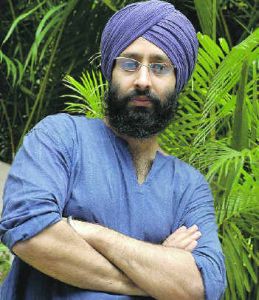 Rabbi Shergill fan in the audience and in certain parts of California that isn’t too surprising. Although my friends and family made fun of me, they were kind compared to the rest of the audience. The audience yelled their ever-so-kind “Eh ki bakwas hai? Bhangra Ga!” (What is this crap? Sing Bhangra!) and began to boo him off the stage in the middle of his ‘Chhalla’ performance. Although I love my hometown, sometimes we are stupid.
Rabbi Shergill fan in the audience and in certain parts of California that isn’t too surprising. Although my friends and family made fun of me, they were kind compared to the rest of the audience. The audience yelled their ever-so-kind “Eh ki bakwas hai? Bhangra Ga!” (What is this crap? Sing Bhangra!) and began to boo him off the stage in the middle of his ‘Chhalla’ performance. Although I love my hometown, sometimes we are stupid.
Rabbi’s first self-titled album played in my car for months straight. Despite the ridicule of all of my friends, I was mesmerized by his brilliance. In my own version of ‘elitism,’ I just thought they couldn’t “understand” Rabbi. How brilliant was this contemporary music artist not only recreating but reinterpreting classic poetic metrics and musical composition forms with current political and social content. While his “Bulla Ke Jana” garnered critical attention and success, for me his “Jugni” with its political content, “Totia Manmotia” for its social charge and reinterpretation of a whimsical Mughal-period popular dialogue between parrots, and the thrilling rendering of his Shiv Kumar Batalvi in “Ishtihar” sent tingles down one’s spine. Sepia Mutiny’s Amardeep criticized Rabbi’s earlier supposed “Sufi/Sikh spiritualist” image, however, such a reading could only be made by one that had never listened past “Bulla Ke Jana.”
Although three years in the making, Rabbi returns with a new album Avengi Ja Nahin (the website includes song samples, videos, and even lyrics). The album has 9 tracks and I have yet to listen to all of them. The cover song “Avengi Ja Nahin” is a nice love song. The other song to gain much attention is his “Biqlis” that provides a voice to the many voices lost during the anti-Muslim government-sponsored pogroms in Gujarat in 2002. The song is stirring, being both patriotic but critical.
Punjabis can argue whether Gurdas Mann’s classic Chhalla from the movie Laung Da Lishkara is the best or Rabbi’s new rendering. For my vote, I just want to add that Rabbi is on the world stage singing Punjabi (in his Jugni invoking that the solution to today’s problems was to invoke the Guru’s name), while during the 1980s and early 1990s Gurdas Mann went to Bombay and record plenty of Hindi content.
However, especially important for a Sikh audience would be a discussion on his song “Pagri Sambhaal Jatta.”
Over the past few years the website Sikhitothemax.com has become one of the premier tools for English-fluent Sikh youth to access their Guru Granth Sahib. While STTM has problems that can be addressed at another time, it is important to realize the effect that this tool has had. 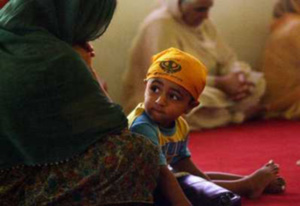 Many Gurdwaras throughout the world have added STTM translations as part of their regular programs and the projection system in the Gurdwara is fast becoming the norm.
Many Gurdwaras throughout the world have added STTM translations as part of their regular programs and the projection system in the Gurdwara is fast becoming the norm.
But is it enough?
In a recent article in the Fresno Bee, reporter Vanessa Colon looks at the question of “losing tradition in translation.”
Colon interviews a number of Central Valley Sikhs and finds that the Sikh youth are often not engaged with their Gurdwara. Although there a number of reasons, she delves into the question of language first and foremost. Some local Fresno Sikhs blamed the Sikh youth for not learning enough Punjabi. However, I see that this approach has problematic for there are now a number of Punjabi/Khalsa schools in California and beyond. However, instruction one day a week for an hour will not ever provide a sufficient language base for one to understand Gurbani.
There’s been some controversy over the upcoming film, ‘Singh is Kinng,’ [sic] starring Akshay Kumar and a host of other Indian actors I don’t know, scheduled to hit theatres on August 8th.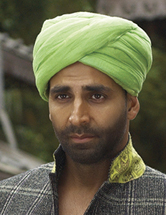
Singh is Kinng is a story about Happy Singh, a Punjabi Sikh. He is very mischievous and gets involved in a number of disastrous situations, so the villagers plan to send him to Australia to bring back his fellow villager, Lucky Singh. It is then revealed that Lucky is a underworld Don in Australia. Then, in a accident, Happy saves Lucky but still Lucky becomes paralysed. Hence, Happy becomes the new King of the Australian Underworld. [link]
For those who haven’t been following the controversy- the problem revolved around the portrayal of Sikhs in the movie (physical appearance as well as particular scenes). I haven’t seen much information on the scenes, but am assuming that they involve explicit conduct that was found offensive to screeners’ moral sensibilities. As for the the physical appearance, I can’t exactly blame critics after seeing what “Singhs” look like in the movie… (see picture on right). Um… I don’t know who tied his pag or what it’s made of or what type of fashion statement the movie is trying to make, but I don’t think any Singh I know would ever wear that.
Earlier in the month, an East Panjabi newspaper editor, Baljit Brar, posed the possibility that Pakistan stood to earn up to $500 million per year by promoting Sikh tourism.
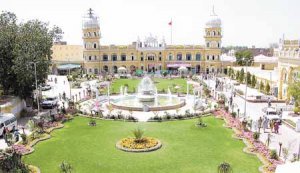 Brar suggests that since the airport in Lahore is more convenient and is better maintained than that in Amritsar, with better border mobility the Lahore airport could be the airport of choice for diasporic Sikhs. Many Sikhs have bought into the ‘Romance that is Panjabiyat,’ including at-times the present langa(w)r-iter. While Brar’s numbers may be grossly optimistic, I do believe that many Sikhs would love to take advantage of new tourism and travel opportunities.
Brar suggests that since the airport in Lahore is more convenient and is better maintained than that in Amritsar, with better border mobility the Lahore airport could be the airport of choice for diasporic Sikhs. Many Sikhs have bought into the ‘Romance that is Panjabiyat,’ including at-times the present langa(w)r-iter. While Brar’s numbers may be grossly optimistic, I do believe that many Sikhs would love to take advantage of new tourism and travel opportunities.
Many Sikhs left West Panjabi villages and cities in their stead in 1947. Another langa(w)r-iter had commented on the traumas of Partition. The opportunity to revisit one ancestral home may be part of the process in healing old wounds.
Brar makes a number of suggestions. In a world where economics flows across borders, new opportunities may avail themselves to the Sikhs to increase the prosperity of Panjab. One hopes governments can help create an environment where greater flows are possible. I definitely have longed to visit West Panjab. What about you? Is something like this feasible?
In Ludhiana, a 29 year old woman, Hardeep Kaur, was just found dead at her in-laws house. Her brother, Harpreet Singh, informed the police that she had been frequently harassed by her in-laws about a dowry, and he alleged that the in-laws murdered her. According to Harpreet, Hardeep had just recently returned to her in-laws house under the assurance that she wouldn’t be harassed again. [link]
Considering the circumstances, it seems the assurances were false. Hardeep leaves behind a 7 year old son and a 1 and 1/2 year old daughter.
and a 1 and 1/2 year old daughter.
According to sources, Hardeep’s brother Harpreet Singh, a resident of Vishkarma colony under the Shimlapuri police station, received a call from Hira Singh’s brother-in-law Karamjit Singh informing that Hardeep had died under mysterious circumstances. He said when he went to his sister’s house, he found the house empty and the body of Hardeep was lying in a room. [link]
No arrest has been made yet, and Hardeep’s body has been sent for a post-mortem.
The race for dowry, in my opinion, is linked to the over-extravagance of weddings. Dowries used to be functional when weddings used to be functional. But as weddings have become status symbols, so has everything associated with them – the boutique/designer a bride buys her wedding clothes from, the weight of gold and diamonds, the type of transportation she and the groom use to get to the wedding/reception (apparently helicopters are in these days).
We’ve discussed before whether and how the Anand Karaj has lost its meaning to the afterparty. In cases where attention is entirely or even mostly on the materialistic aspects of the wedding, or where the result is similar to Hardeep’s, it definitely has.
![]()
A little while ago, we mentioned a census commissioned by the Punjab government and being conducted by the Punjab Agricultural University, Ludhiana, documenting the rates of farmer suicides in Punjab.
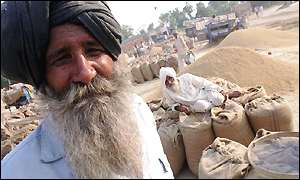 An interesting development is an independent study conducted by a group called the “Movement Against State Repression,” a Chandigarh based non-profit organization which seems to be working with patwaris in Sangrur.
An interesting development is an independent study conducted by a group called the “Movement Against State Repression,” a Chandigarh based non-profit organization which seems to be working with patwaris in Sangrur.
Inderjit Singh Jaijee, convenor of the Movement Against State Repression (MASR), has said patwaris in Sangrur district have collected information with regard to the cases of suicide by farmers. [link]
This is a positive development because the findings of the PAU can now be measured against the findings of MASR, at least in Sangrur, to ensure the truth of the figures. This is especially important because PAU is known to heavily push farmers to use pesticides which are harmful to the land, the farmers, and one factor of the recent agricultural decline of Punjab.
A movie produced by some Singhs is in theatres… if anyone catches it, give us a review!
In Los Angeles circa 1915, a little immigrant girl (Catinca Untaru) is in a hospital recovering from a fall. She strikes up a friendship with a bedridden man (Lee Pace), who captivates her with a whimsical story that removes her far from the hospital doldrums into the exotic landscapes of her imagination. Making sure he keeps the girl interested in the story he interweaves her family and people she likes from the hospital into his tale. Shot on location in 18 countries around the world, The Fall is a moving, visually sumptuous fantasy of exotic bandits, evil tyrants, dream-like palaces and breathtaking landscapes. Directed and co-written by Tarsem Singh (The Cell). Executive Producer- Ajit Singh. [link]
An interesting case arose recently in Canada– Av Singh, a British Sikh, was fired from a Canadian company because his beard raised safety concerns relating to the proper use of a required gas mask.
Removing the beard is against his religious beliefs, so Singh refused the razor and instead hired a human-rights lawyer. [link]
The point that has raised controversy is the length of his beard- about 5 mm (pictured on the right). The objection has been raised by some that he isn’t entitled to protection, becuase he doesn’t keep a full beard.
Now, if this guy is just using religion as an excuse because it’s convenient, then this case is not so hard- religious protection for convenience de-legitimizes real cases of religious discrimination for people that are truly trying to follow and practice the faith. Maybe it won’t be too hard to figure out whether this guy is sincere or not (but maybe it will). But my concern, and the tension, in my eyes, is – where do we draw the line?
I don’t want to underestimate the importance of the physical appearance of a Sikh. But is anyone who doesn’t completely follow the Rehat undeserving of religious protection? Under that definition, there are few real Sikhs in the world, and many that are trying to follow the path want protection against discrimination at airports and on the streets. Why should protection for physical appearance be given over internal belief- just because it’s easier to discern?
Time for another Retreat! This time around its Saanjh and its happening from September 4th to September 7th in the Monte Toyon camp and conference center in Santa Cruz, California.
 According to their website:
According to their website:
The retreat will feature interactive workshops and discussions that will explore topics such as understanding the Guru, exploring our relationship with the Guru, Sikh identity and culture, visiting our recent and past history, Sikh politics and activism. We will utilize an interdisciplinary approach featuring spiritual, philosophical, cultural, historical, political, and activist angles to explore these diverse topics. There will also be different fun activities, sports and games to engage us. We hope to challenge participants to gain a broader and more nuanced understanding of what it means to be a Sikh while inspiring activism.
Registration is now open, and the early registration ends on July 15th, if you plan on attending than register now to avoid the late fees. For more information visit www.saanjh.org
